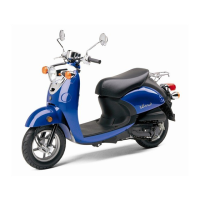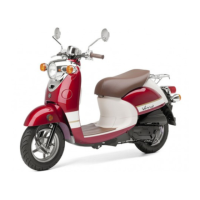Do you have a question about the Yamaha VITY XC125E and is the answer not in the manual?
Owner's responsibility and essential safe riding practices for scooter operation.
Importance of protective apparel, helmets, and avoiding carbon monoxide hazards.
Guidelines for adding cargo, accessories, and warnings about aftermarket parts.
Safe riding points, braking advice, and specific road condition precautions.
Identification of key parts from left and right views of the scooter.
Explanation of dashboard controls, indicators, and instruments.
Operation of the ignition, lighting, and steering lock mechanisms.
Functions of warning lights, indicators, oil change alerts, speedometer, and fuel gauge.
Operation of dimmer, turn signal, horn switches, and brake levers.
Procedures for accessing the fuel tank and seat, and fuel safety.
Use of helmet holders, storage compartments, and ignition cut-off system.
Step-by-step guide for starting the scooter's engine safely.
Instructions for starting off, acceleration, deceleration, and braking.
Advice on fuel economy, braking, and the engine break-in period.
Proper methods for parking the scooter and associated safety warnings.
Overview of periodic checks, adjustments, and lubrication for vehicle upkeep.
Maintenance tasks for fuel lines, spark plugs, engine oil, final transmission oil, and V-belt.
Procedures for inspecting and maintaining brakes, wheels, tires, and related components.
Maintenance for front fork, steering, battery, fuses, and cables.
A chart to diagnose and resolve common starting and running problems.
Guidelines for cleaning different parts of the scooter, including warnings for special finishes.
Instructions for short-term and long-term storage of the scooter to prevent damage.
Key physical measurements and weight specifications for the scooter.
Details on engine type, oil, fuel capacity, and transmission system.
Specifications for suspension, brakes, electrical system, and bulbs.
Location and importance of vehicle identification number and model label for parts ordering.
Owner's responsibility and essential safe riding practices for scooter operation.
Importance of protective apparel, helmets, and avoiding carbon monoxide hazards.
Guidelines for adding cargo, accessories, and warnings about aftermarket parts.
Safe riding points, braking advice, and specific road condition precautions.
Identification of key parts from left and right views of the scooter.
Explanation of dashboard controls, indicators, and instruments.
Operation of the ignition, lighting, and steering lock mechanisms.
Functions of warning lights, indicators, oil change alerts, speedometer, and fuel gauge.
Operation of dimmer, turn signal, horn switches, and brake levers.
Procedures for accessing the fuel tank and seat, and fuel safety.
Use of helmet holders, storage compartments, and ignition cut-off system.
Step-by-step guide for starting the scooter's engine safely.
Instructions for starting off, acceleration, deceleration, and braking.
Advice on fuel economy, braking, and the engine break-in period.
Proper methods for parking the scooter and associated safety warnings.
Overview of periodic checks, adjustments, and lubrication for vehicle upkeep.
Maintenance tasks for fuel lines, spark plugs, engine oil, final transmission oil, and V-belt.
Procedures for inspecting and maintaining brakes, wheels, tires, and related components.
Maintenance for front fork, steering, battery, fuses, and cables.
A chart to diagnose and resolve common starting and running problems.
Guidelines for cleaning different parts of the scooter, including warnings for special finishes.
Instructions for short-term and long-term storage of the scooter to prevent damage.
Key physical measurements and weight specifications for the scooter.
Details on engine type, oil, fuel capacity, and transmission system.
Specifications for suspension, brakes, electrical system, and bulbs.
Location and importance of vehicle identification number and model label for parts ordering.











